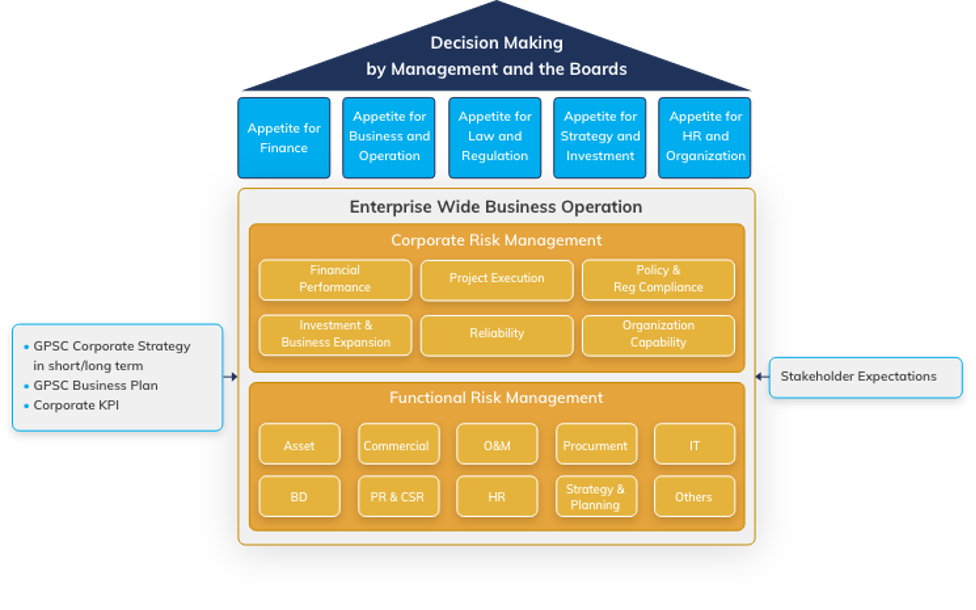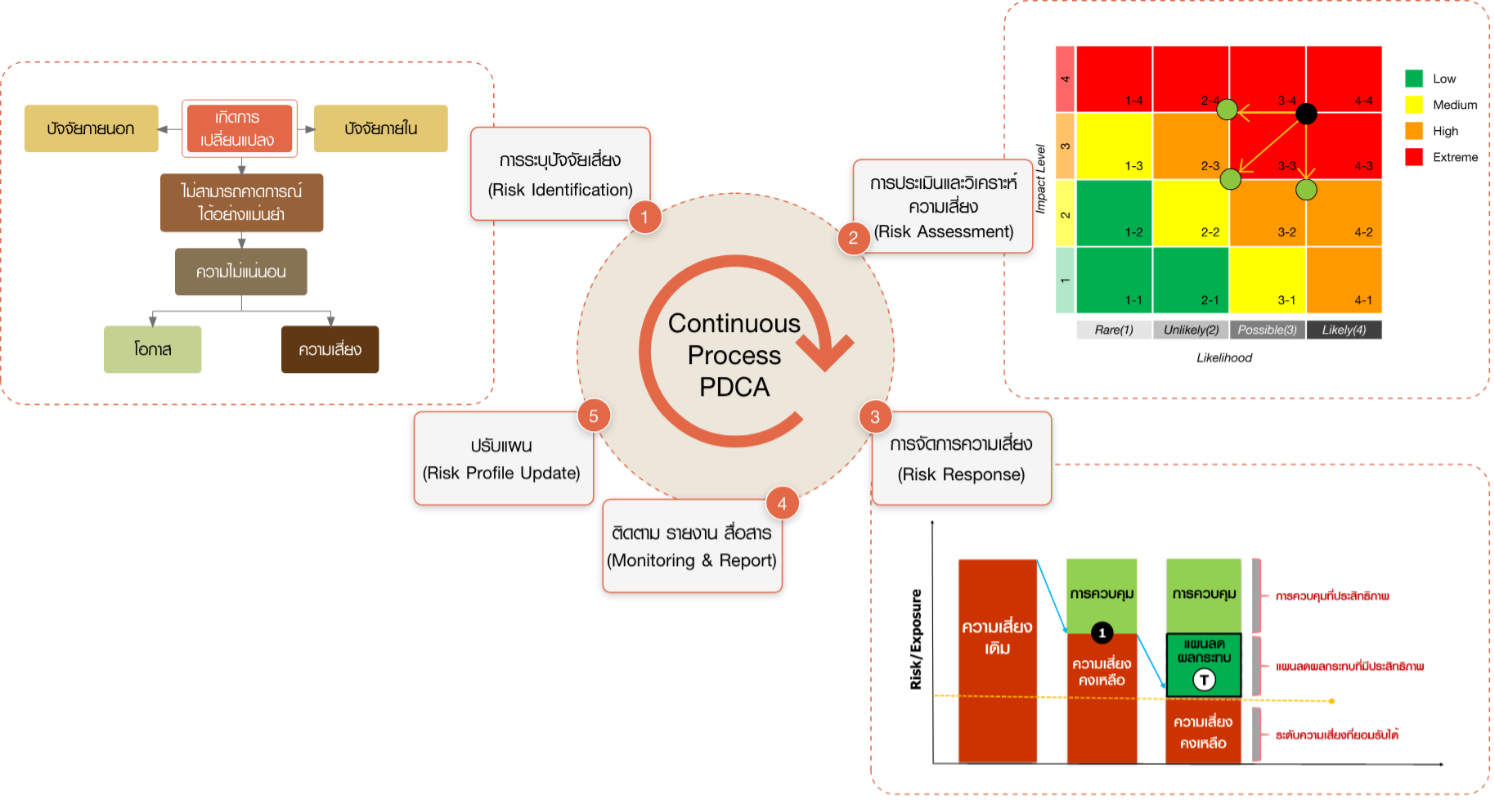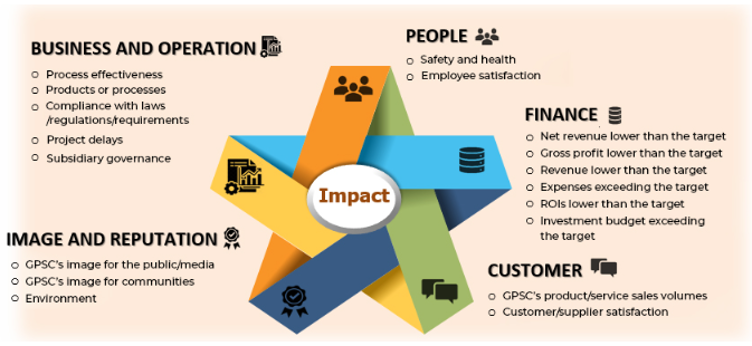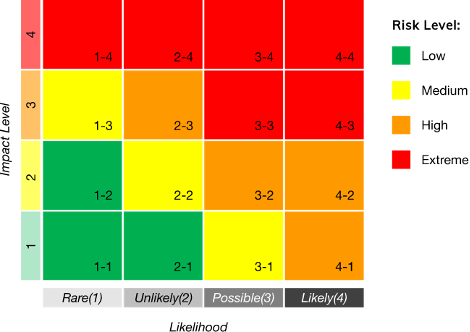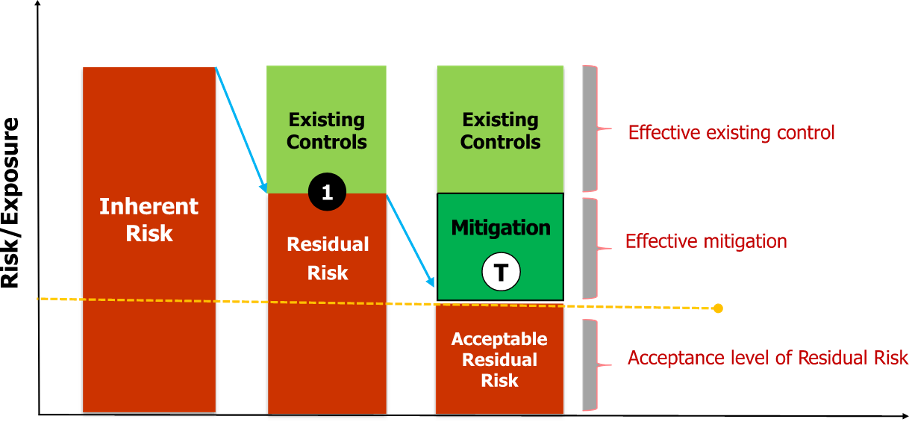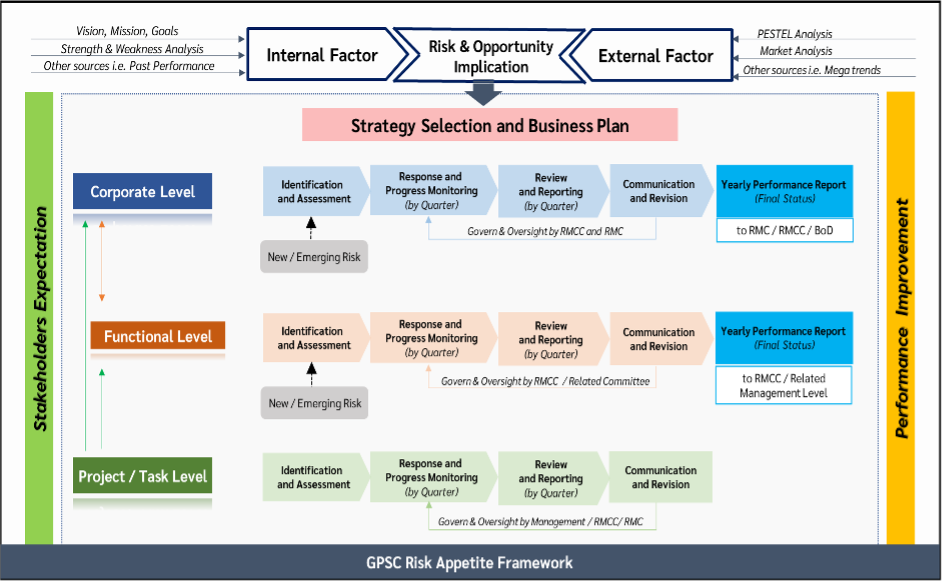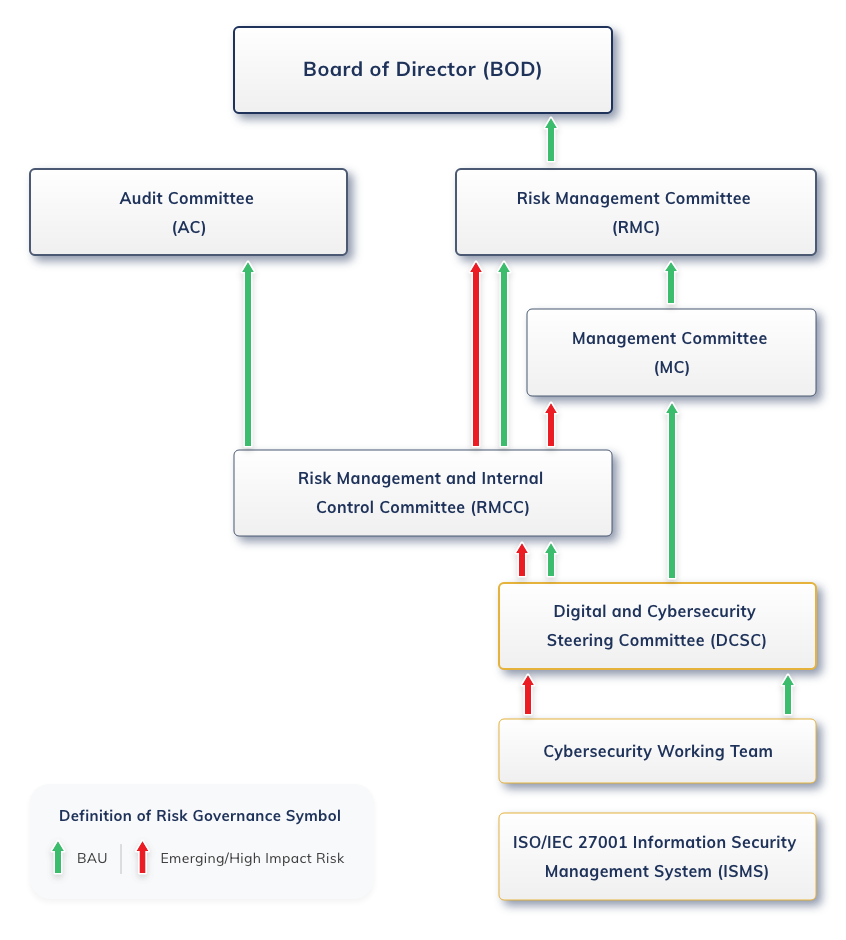| 1. Geopolitical risks and global economic risks |
High |
2023 |
Geopolitical conflicts as well as the volatility of the money market, the capital market, and the production and consumption sectors due to sensitive economic conditions have resulted in limitations and created conditions for the business operations and operating results of the Company and GPSC Group. |
- Failure to achieve operating result targets as a result of increases in fuel and energy prices and of electricity tariffs determined by the government that did not reflect actual cost condition
- Impacts of financial policy management amid inflation and international economic stagnation on GPSC’s financial costs and expenses
- Impacts of regional and national geopolitical conflicts on GSPC’s operations under its expansion strategies
|
- Manage impacts on the operating results by utilizing reference fuel prices formulas, selling electricity to fulfill power purchase agreements, carrying out plant optimization, and coordinating with relevant external agencies.
- Undertake risk management through the Hedging Committee and monitor interest rates and financial costs to identify suitable financial instruments.
- Manage risks and impacts that have arisen, from reviewing and selecting investment projects, for which potential short-term and long-term impacts are assessed, to fostering local business allies as well as studying and monitoring the in-depth business environment through personnel stationed local areas and considering exit strategies when suitable.
|
| 2. Cybersecurity Risk |
Medium |
2026 |
Cyber threats can cause significant impacts on GSPC’s information technology management and work processes and management carried out online or in an online system. As digital technologies have improved operational efficiency and become much more widely used-particularly in the power generation business, every facet of operations at GPSC’s plant facilities and offices rely heavily on digital technologies and the internet. In addition, the need to adapt and work from homes amid the COVID-19 pandemic has necessitated the connection with the external internet. Also, in response to behavioral changes brought on by the new normal as well as global trends and digital transformation, GPSC has actively applied digitalization practices to its business context and created suitable IT infrastructure and management to avoid negative impacts. Thus, cybersecurity has become more important, and IT threats accompanying internet connections have become unwelcome risks.
|
- Leak of the Company’s confidential information
- Disruption of IT systems, affecting production and distribution systems, and thereby GPSC's reliability
- Fines and penalties by regulators
- Potential to harm GPSC’s financial and social capital
- Loss of reputation, reliability, and stakeholder trust
- Loss of business opportunities and revenue
- Increase in infrastructure, operating, and insurance costs
|
- Appoint a Digital and Cybersecurity Steering Committee (DCSC) to oversee and drive change management, assess digital risks and cybersecurity, and screen various projects to ensure alignment with GSPC’s strategies and businesses.
- Monitor compliance with GPSC’s cybersecurity policy and provide practical guidelines in compliance with the international information security management system standard (ISMS, ISO 27001:2013).
- Educate the workforce and raise their awareness of various forms of IT threat and related procedures for protecting against; and hand over a list of threats for each operational site to prevent damage to GPSC from escalating.
- Periodically test the system with self-instructed decoys and compile lessons learned to nurture awareness for all employees on the use of information technology.
- Regularly organize drills for employees to respond to IT threats for office support functions.
- Regularly perform data system tests and system recovery drills in case of emergency threats to power generation sites.
- Regularly update relevant cyber-related law and regulations.
|
| 3. Disruptive technology risks |
High |
2027 |
As a result of rapid changes in customer and consumer energy consumption behaviors, as well as advancements in technologies such as Blockchain and IoTs, businesses need to adapt to remain competitive and develop innovations for future growth. Additionally, disruptive technology has rapidly driven changes in energy technology, leading to shifts in consumer behavior for both industrial and public users and a transition to renewable electricity, such as EVs, heavily influenced by the push for sustainability. These uncertainties are inevitable and may affect GPSC’s competitiveness against other players in the energy market. |
- Decreased competitiveness if GPSC is unable to adapt to technological changes
- Loss of reputation, reliability, and stakeholder trust
- Loss of business opportunities, market shares, and revenue
|
- Invest in new S-Curve business models to support long-term expansion in battery and ESS businesses and other related businesses.
- Actively develop a system integrator that can be integrated into the current business.
- Formulate adaptation plans in support of the market for new forms of energy trade and develop new energy trade platforms consistently to cater to new consumer behavior while also reducing impacts on the power generation and distribution business both at present and in the future.
- Study and develop carbon capture utilization and storage (CCUS) technology and hydrogen businesses in preparation for limitations/obstacles related to GHG emissions and to create opportunities for new alternative businesses in the future.
|
| 4. Changed Rules and Regulations |
High |
2027 |
As for the energy transition agenda in the global context, the increased challenge of renewable energy generation and distribution has become an attractive topic. Adopting the change regarding this trend leads to new challenges for the competitive market and emerging business. Likewise, this has been addressed as an emerging risk related to the unforeseen uncertainty of the new and restrict coming regulations, policies, and measures in Thailand within 3-5 years. Particularly, the electricity tariff mechanism. An emerging risk driven from the changed in rules and regulation derived from energy transitions is recognized to potentially cause direct business impact to GPSC.
These are, for examples, the implementation of renewable energy transition policy and regulation through the pilot scale project from Energy Regulatory Commission (ERC) which aims to scale up at the macroscale. This leads to the amendment of regulations on new industry structure. One of the potential released regulations is the new system fee of electricity, which is so-called utility green tariff (UGT) i.e. UGT1 and UGT2. This is influentially deemed the dynamic change to GPSC’s direction owing to the driving of renewable energy role on the electricity mixed grid. With this regard, ERC allows third party to connect with the grid through the Third-Party Access (TPA). The TPA has been remarked as a challenge to GPSC in the competitive market for the energy trading and renewable energy capacity in the portfolio.
These are the drivers that trigger GPSC to expand the renewable energy capacity in the market among renewable energy buyers and prepare for those regulations.
|
- The competitive market is also one of the challenges for new renewable energy businesses of GPSC in the market share context. In a highly competitive market, companies have to compete for customers, and they may have to lower their prices or offer better products or services to attract customers away from their competitors. This can result in a decline in market share and revenue for GPSC if the company is unable or unwilling to adapt to the changing market conditions.
- The applicable electricity tariff from newly changed policies and regulations can influentially impact GPSC as generated revenue, which is uncertain, particularly imposing the electricity fee through the UGT mechanisms, i.e., UGT1 and UGT2.
|
- Increasing the renewable energy in portfolio in responding the market expectation for trading through corporate strategy S2: Scale-up green energy. Prepare the renewable energy expansion plan to serve the renewable energy market demand as a key player in the competitive market.
- Engaging with stakeholders, peers, and regulators to ensure that GPSC stay up-to-date on policies and market changes and to take an advantage of new opportunities for impact and enhancement.
- Study on the tariff structure and potential changes in the rules and regulations based on the new coming policies that directly relevant to the GPSC’s businesses to ensure the benefits from new business related to the change.
- Develop strategy of renewable energy trading through platform to secure the real time monitoring as part of new renewable energy business.
- Reaching out to the new buyers in the renewable energy market to expand market shares.
|
| 5. Organizational Capability |
High |
2027 |
Driving the growth of GPSC in the highly competitive market and changes of human capability need in the market conditions require the human resource competency to strengthen GPSC’s position in all business opportunities. The core driver in doing the value creation and delivery can be inferring all functions across the company.
It is the most potential capability of human resource to raise GPSC as a key player in the energy sector. In this respect, strategic corporate expansion and low carbon transition of GPSC associated with the global trends have consistently been prioritized in the GPSC’s business strategy and direction.
Nevertheless, the limitation is existed as the current in the transformation phase, which results in the one main barrier to continuing the long-term strategic plan of GPSC. This has become a threat to the continuous improvement of businesses, especially emerging businesses such as advanced renewable energy and low carbon technologies, energy storage system, and digital technology. These are the influential global trends that are rapidly changed and create the significant impact to GPSC’s businesses. Overall, unwell adopting can be shown as the highly potential risk to a company's long-term success and sustainability. Thus, organizational capability and human competency are essential for managing and adapting emerging risk derived from the global change and agenda.
|
- Lacking appropriate and necessary expertise, technical skills, and knowledge in adapting to global change can restrict the consecutive development of GPSC.
- Lower quality of value creation and delivery than the anticipated target. This leads to the negative consequences, for example, reduced customer satisfaction and trust, decreased reputation and credibility, and lower profits.
- Rapidly change in the global agenda can highly reduce the overall of GPSC’s performance by lead time, which can cause decreased productivity, increased costs, and strained relationships with clients or stakeholders.
- Misalignment between international trends and low GPSC’s capability can further cause the positions in the market opportunities.
|
- Establishing an initiative development program in each particular function across the company.
- Collaborate across external partner and network in exchanging knowledge in the energy industry.
- Monitor and track global trends to early adopt into business practice.
- Integrates an intuitive platform to training courses for all level functions across the company.
- Build the flexible workplace culture regarding modern working model that can enhance the working efficiency.
- Apply an incentivization concept to drive GPSC’s growth by valuable capability.
- Encourage people to work in their expertise or right work and task to create and deliver the maximum outcome.
- Being proactive in anticipating and adapting to global trends to gain a competitive edge and create new business opportunities.
|














